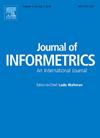Measuring the university–industry–government relations synthesized by the Triple Helix and the diversity
IF 3.5
2区 管理学
Q2 COMPUTER SCIENCE, INTERDISCIPLINARY APPLICATIONS
引用次数: 0
Abstract
Synthesizing the triple helix model and diversity, we introduce two novel indicators, involvement (IV) and interaction (IA), which are established upon the fusion of the triple helix concept and three extended attributes of diversity: proportion, balance, and disparity. These indicators are designed to evaluate one-dimensional involvement and two-dimensional and three-dimensional interaction within university-industry-government (U-I-G) relations. The empirical examination is conducted using two datasets related to CRISPR and fullerene, derived from the Web of Science. Our findings highlight a markedly higher level of involvement within universities compared to industries and governments, attributed to the dominant proportion of universities. We observe that different two-dimensional interactions render distinct performances on the three attributes. The interaction within U-I-G remains relatively low due to the low proportion. We further contrast IV and IA with the triple helix and transmission efficiency metrics, observing distinct differences among them. Consequently, we suggest that through the synthesis of the triple helix and diversity, IV and IA provide a more thorough understanding of involvement and interaction within U-I-G relations, and can inform strategies for their enhancement. The application of IV and IA can potentially extend to examining varying collaborative innovations within other triple or quadruple relations.
三螺旋合成的校企关系及其多样性测度
综合三螺旋模型和多样性,引入了两个新的指标,即参与(IV)和交互(IA),这两个指标是在三螺旋概念和多样性的三个扩展属性:比例、平衡和差异的融合基础上建立的。这些指标旨在评估大学-产业-政府(U-I-G)关系中的一维参与以及二维和三维互动。实证检验使用了两个与CRISPR和富勒烯相关的数据集,这些数据集来自科学网。我们的研究结果强调,由于大学占主导地位,大学内部的参与程度明显高于行业和政府。我们观察到,不同的二维相互作用对这三个属性的表现是不同的。由于比例较低,U-I-G内部的相互作用相对较低。我们进一步将IV和IA与三螺旋和传输效率指标进行对比,观察到它们之间存在明显差异。因此,我们建议通过三螺旋结构和多样性的综合,IV和IA提供了对U-I-G关系中参与和相互作用的更彻底的理解,并可以为增强U-I-G关系提供策略。IV和IA的应用可以潜在地扩展到检查其他三重或四重关系中的各种协作创新。
本文章由计算机程序翻译,如有差异,请以英文原文为准。
求助全文
约1分钟内获得全文
求助全文
来源期刊

Journal of Informetrics
Social Sciences-Library and Information Sciences
CiteScore
6.40
自引率
16.20%
发文量
95
期刊介绍:
Journal of Informetrics (JOI) publishes rigorous high-quality research on quantitative aspects of information science. The main focus of the journal is on topics in bibliometrics, scientometrics, webometrics, patentometrics, altmetrics and research evaluation. Contributions studying informetric problems using methods from other quantitative fields, such as mathematics, statistics, computer science, economics and econometrics, and network science, are especially encouraged. JOI publishes both theoretical and empirical work. In general, case studies, for instance a bibliometric analysis focusing on a specific research field or a specific country, are not considered suitable for publication in JOI, unless they contain innovative methodological elements.
 求助内容:
求助内容: 应助结果提醒方式:
应助结果提醒方式:


